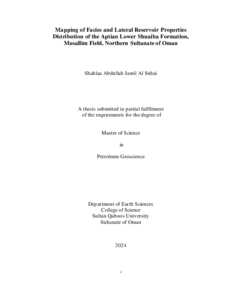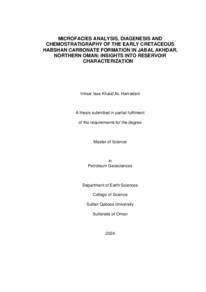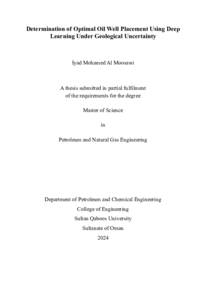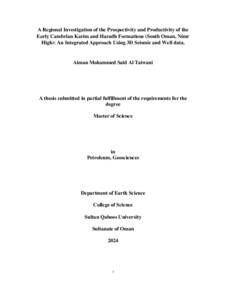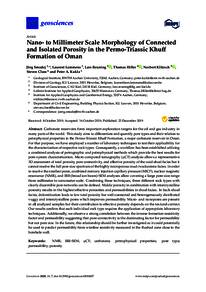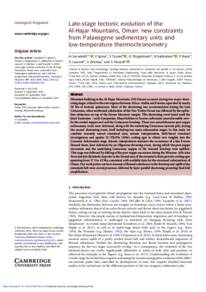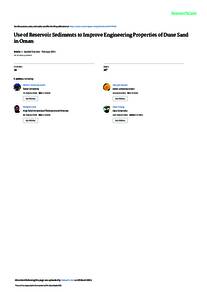Document
Mapping of facies and lateral reservoir properties distribution of the aptian lower Shuaiba formation, Musallim Field, Northern Sultanate of Oman.
Source
Master's thesis
Other titles
رسم خرائط السُحنات وتوزيع خصائص الخزان الجانبية لتكوين شعيبة السفلي، حقل ُمسلم، شمال سلطنة عُمان
Country
Oman
City
Muscat
Publisher
Sultan Qaboos University
Gregorian
2024
Language
English
Subject
Thesis Type
Master's thesis
English abstract
The Lower Shuaiba Formation is one of the complex carbonate reservoirs in the
Middle East that are characterized by extensive textural heterogeneity that corresponds
to highly variable reservoir properties. This heterogeneity is related to discrepant
depositional settings during the Shuaiba deposition and the digenesis, which had a
severe overprint on the original properties. Facies mapping is important to unlock the
uncertainties of facies distribution and characterization, highlighting the extent of good
quality facies within the reservoir. The key objectives of this study are to capture the
lateral distribution of reservoir properties within the Lower Shuaiba in the Musallim
Field by identifying facies types and mapping their spatial distribution.
The approach used in this study involved a specific workflow that implemented
many datasets to capture reservoir heterogeneity and develop a facies model for the
Lower Shuaiba in the field. Geological, seismic, petrophysical, well, dynamic, drilling
data, and microfacies analysis are all included in the dataset. This work contains a
detailed methodology of reservoir rock typing application that is used for predicting the
reservoir characteristics of uncored intervals by integrating petrophysics and
sedimentology. The final developed maps and models represent the reservoir's internal
architecture, highlighting the different expected facies types, their trends, and the
expected reservoir quality.
The abundance of the Algal-rich characterizes the reservoir in the field area and
represents the dominated facies, which cover most of the topmost 10-20 m of the
reservoir. The regional depositional setting for the field is a shallow lagoon with
restricted open marine input caused by penecontemporaneous buildups. Reservoir
quality is primarily governed by diagenesis, not only by facies types. The abundance and
arrangement of lithofacies rich in large skeletal allochems, such as the Algal-rich and
Rudist-rich dominated lithofacies, play a pivotal role. Dissolution enhancement in these
lithofacies fosters more effective connectivity among pores, distinctly surpassing the
pore network of the Wackestone-dominated lithofacies. Most connected pores are
interpreted as being created by the acidic, aqueous, unsaturated fluids that preceded/or
came with hydrocarbon charge time. Depositional heterogeneities, subsequent diagenetic
modifications, and structural adjustments have controlled the development and
distribution of lateral reservoir properties.
Arabic abstract
خزان شعيبة السفلى هو أحد خزانات الكربونات المعقدة في الشرق الاوسط التي تتسم بعدم التجانس التركيبي الواسع الذي يتوافق مع خصائص المكمن المتغيرة للغاية. يرتبط هذا التباين باختالف خصائص الترسيب أثناء ترسيب خزان شعيبة والتغيرات التالية للترسيب، الذين أديا إلى تغيرات كبيرة على الخصائص الاصلية. وتتسم عملية رسم خرائط السحنات بالاهمية في الكشف عن الشكوك المتعلقة بتوزيع السحنات وتوصيفها، وبالتالي تسليط الضوء على خصائص السحنات داخل الخزان. تتمثل الاهداف الرئيسية لهذه الدراسة في تحديد التوزيع الجانبي لخصائص الخزان داخل منطقة شعيبة السفلى في حقل مسلم من خلال تحديد أنواع السحنات ورسم خرائط لتوزيعها المكاني. يشمل النهج المستخدم في هذه الدراسة على خطة عمل تم فيها استخدام العديد من مجموعات البيانات لتحديد سبب عدم تجانس الخزان وتطوير نموذج وخريطة السحنات لتكوين شعيبة في الحقل. وتتضمن مجموعة البيانات المستخدمة: البيانات الجيولوجية، والزلزالية، والبتروفيزيائية، والابار، والديناميكية، وبيانات الحفر، وتحليل مفصال لتحديد نوع الصخور داخل الخزان، والتي تستخدم للتنبؤ تطبيقا السحنات الدقيقة. يتضمن هذا العمل بخصائص الخزائن للمناطق غير المحفورة من خلال تكامل كل من المعلومات البتروفيزيائية والرسوبية. وتمثل الخرائط والنماذج النهائية التي تم تطويرها البنية الداخلية للخزان، حيث تبرز مختلف أنواع السحنات المتوقعة واتجاهاتها وجودة الخزان المتوقعة. يتميز الخزان الموجود في منطقة الحقل بوفرة السحنات الغنية بالطحالب حيث تغطي معظم الجزء العلوي من الخزان الذي يتراوح سمكه ما بين ١٠ إلى ٢٠ مترا . البيئة الترسيبية الاقليمية للحقل عبارة عن بحيرة ضحلة ذات مدخلات بحرية مغلقة. تعتمد جودة الخزان في المقام الاول على التغيرات التي حدثت للخزان بعد الترسيب، وليس فقط على أنواع السحنات. تلعب وفرة وترتيب السحنات الغنية بالهياكل الصلبة الكبيرة، مثل السحنات الذوبان في هذه السحنات اتصالا الصخرية الغنية بالطحالب والرودست دو را محوري ا. يعزز أكثر فعالية بين المسام، متجاو زا بشكل واضح شبكة المسام في السحنات التي يهيمن عليها الحجر الجيري الواكي. تم تفسير غالبية المسام المتصلة على أنها تطورت بواسطة السوائل المائية الحمضية غير المشبعة التي سبقت/أو جاءت مع وقت انتقال الهيدروكربون من صخر المنشأ. لقد ساهم عدم التجانس الترسيبي، والتغيرات التالية للترسيب )العمليات التحويرية(، والاحداث التكتونية في التحكم في تطوير المكمن وتوزيع خصائصه الجانبية
Category
Theses and Dissertations

